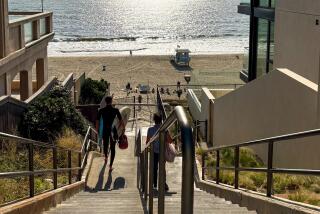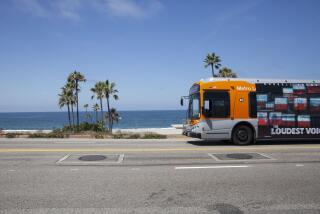CLIPBOARD : DISCOVERY : The Placentia Trolley
- Share via
A mother and her twin toddler daughters rode to the Human Services Center beside McFadden Park to pick up their 4-year-old brother from his preschool Head Start class. An older woman, picked up outside the Villa de Palma Senior Home, went to the market to shop for groceries. Three handicapped young men and an instructor embarked at Tri-City Park on Golden Avenue for a morning’s outing.
All were passengers on Placentia’s red-and-green trolley, a free public service provided by the city. It travels 17 miles, makes 31 scheduled stops and completes its loop route from the starting point at Melrose Street at McFadden Park in an hour and 15 minutes. Passenger accommodations are maple-stained wooden seats resembling park benches, attached to the floor by wrought-iron legs painted green.
Among the trolley stops are the Civic Center (City Hall and the Placentia Library), the post office, the Placentia-Linda Community Hospital, all city parks and all the shopping centers. It also calls at the senior citizen centers and mobile home parks. Drivers keep to the schedule within a grace period of 15 minutes, allowing whatever time passengers need to embark or disembark.
In its first few months after October, 1989, when trolley service began, most people traveled just for the ride and the tour of the city. Today, the trolley has been integrated into the city’s life. Passengers include employees bound for work, mothers taking their children to school, senior citizens running errands, young people destined for the parks, and the occasional tourist out to see the sights.
The trolley provides a valuable service not only for local residents but for some of the county’s disabled as well. The Cole Vocational program, which works with adults who have either mental or physical disabilities, utilizes the Placentia trolley in its community integration lessons.
“The trolley ride teaches (these adults) independence in the community, teaches them what resources are available,” said program manager Susan Dinkel. “It allows them to be exposed to people in a social situation.” In this non-threatening environment, “they can be integrated and be accepted.”
The number of daily riders has risen from an average of 24 in November, 1989, to an average of 60 or more in the spring and summer months. “The season drops off for riders” after the summer, trolley driver Lois Hasell explained in conversation with a passenger.
The lack of direct revenue from the trolley appears to be no serious hardship for the city. Cecil Rospaw, vice chairman of the Placentia Historical Committee, went so far as to say that it may be paying for itself. “Look at the sales tax figures for Placentia--up 6%,” he said.
The trolley represents two things, Rospaw said. “Every person who rides is not driving a car; and every person who rides will make purchases that end up helping the city.”
The city trolley, he says, is “a good example of a very good solution.”
Hours: 9 a.m. to 5 p.m. Monday through Friday; 10 a.m. to 2 p.m. Saturday. Does not run on Sunday.
Telephone: (714) 993-8245
Miscellaneous Information: The ride is free. Trolley schedules (including a map showing the route) are available at City Hall, 401 E. Chapman Ave., and on the trolley.
More to Read
Sign up for The Wild
We’ll help you find the best places to hike, bike and run, as well as the perfect silent spots for meditation and yoga.
You may occasionally receive promotional content from the Los Angeles Times.






